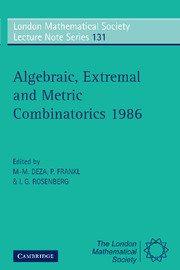Book contents
- Frontmatter
- Contents
- Introduction
- List of Talks
- Participants
- Some Recent Combinatorial Applications of Borsuk-Type Theorems
- On Extremal Finite Sets in the Sphere and Other Metric Spaces
- Metric and Geometric Properties of Sets of Permutations
- Infinite Geometric Groups and Sets
- Intersection and Containment Problems Without Size Restrictions
- Distance-Transitive Graphs of Valency k, 8 ≤ k ≤ 13
- Latin Square Determinants
- A Computer Search for a Projective Plane of Order 10
- Matroids, Algebraic and Non Algebraic
- Algebraic Properties of a General Convolution
- Quasi Groups, Association Schemes, and Laplace Operators on Almost Periodic Functions
- Geometric Methods in Group Theory
- Problem Section
Geometric Methods in Group Theory
Published online by Cambridge University Press: 05 April 2013
- Frontmatter
- Contents
- Introduction
- List of Talks
- Participants
- Some Recent Combinatorial Applications of Borsuk-Type Theorems
- On Extremal Finite Sets in the Sphere and Other Metric Spaces
- Metric and Geometric Properties of Sets of Permutations
- Infinite Geometric Groups and Sets
- Intersection and Containment Problems Without Size Restrictions
- Distance-Transitive Graphs of Valency k, 8 ≤ k ≤ 13
- Latin Square Determinants
- A Computer Search for a Projective Plane of Order 10
- Matroids, Algebraic and Non Algebraic
- Algebraic Properties of a General Convolution
- Quasi Groups, Association Schemes, and Laplace Operators on Almost Periodic Functions
- Geometric Methods in Group Theory
- Problem Section
Summary
Abstract. A survey of recent results which combine techniques from the areas of discrete geometry and finite group theory.
INTRODUCTION
Four years ago, some members of the present audience were also gathered in Montreal, for the 1982 meeting “Finite Groups: Coming of Age” organized by John McKay of Concordia University. At that time, I presented a survey lecture [Sm1] on the comparatively new and rapidly developing area of “groups and geometries”. By now the area has come to be a more established branch of modern mathematics. It seems appropriate to make today's lecture in effect a sequel to that 1982 lecture – to describe further progress on the main problems then open and indicate important new directions which have opened up since that time.
It will be convenient to follow again the general outline of the earlier lecture, namely:
1) Motivation and applications.
2) Background on geometries and diagrams.
3) “Sporadic” geometries.
4) Properties and characterizations.
Of course, events have rendered parts of this organization a little outdated, but the parallel treatment should help emphasize developments since 1982.
MOTIVATION AND APPLICATIONS
At the earlier meeting, I presented “groups and geometries” as an area whose more widespread development had begun in the latter days (late 70's) of the classification of finite simple groups. In overview, that massive result shows that a non–abelian finite simple group must be one of:
Gemoetric Methods in Group Theory
(a) an alternating group;
(b) a group of Lie type, defined qver a finite field;
(c) one of 26 “sporadic” groups – not contained in the families (a) (b).
- Type
- Chapter
- Information
- Algebraic, Extremal and Metric Combinatorics 1986 , pp. 219 - 237Publisher: Cambridge University PressPrint publication year: 1988



